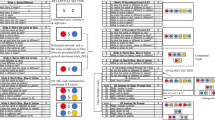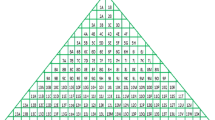Abstract
Previous research suggests the relational evaluation procedure (REP) is a useful means by which to assess and train relational responding. Most work so far has been with adults; however, given the potential utility of the REP for assessing and training relational responding, researchers need to investigate its use with young children. The current series of studies presents relevant data. Study 1 shows correlations between performance on a simple REP-based multi-level protocol (the NSD-REP) and cognitive and linguistic ability in a relatively large (n = 26) sample of typically developing children (aged 2–5). Studies 2–4 involved training REP performance to criterion in a number of these children, using a multiple baseline design across participants in each case to show experimental control. These findings supplement previous data suggesting the utility of the REP for training relational responding in young children.




Similar content being viewed by others
References
Baer, D. M., Wolf, M. M., & Risley, T. R. (1968). Some current dimensions of applied behavior analysis. Journal of Applied Behavior Analysis, 1(1), 91–97. doi:10.1901/jaba.1968.1-91.
Barnes-Holmes, Y., Barnes-Holmes, D., Smeets, P. M., Strand, P., & Friman, P. (2004). Establishing relational responding in accordance with more-than and less-than as generalized operant behavior in young children. International Journal of Psychology and Psychological Therapy, 4, 531–558.
Barnes-Holmes, D., Hayes, S.C., Dymond, S. & O’Hora, D. (2001). Multiple stimulus relations and the transformation of stimulus functions. In S.C. Hayes, D. Barnes-Holmes & B. Roche (Eds.), Relational Frame Theory: A Post-Skinnerian Account of Human Language and Cognition (pp. 51–71). New York: Plenum.
Cassidy, S., Roche, B., Colbert, D., Stewart, I., & Grey, I. (2016). A relational frame skills training intervention to increase general intelligence and scholastic aptitude. Learning and Individual Differences, 47, 222–235.
Cassidy, S., Roche, B., & Hayes, S. C. (2011). A relational frame training intervention to raise intelligence quotients: A pilot study. The Psychological Record, 61, 173–198.
Dymond, S., & Barnes, D. (1995). A transformation of self-discrimination response functions in accordance with the arbitrarily applicable relations of sameness, more-than, and less-than. Journal of the Experimental Analysis of Behavior, 64, 163–184.
Dymond, S., Ng, T., & Whelan, R. (2013). Establishing arbitrarily applicable relations of same and opposite with the relational completion procedure: Selection-based feedback. The Psychological Record, 63, 1–20. doi:10.11133/j.tpr.2013.63.1.009.
Fergusson, D. M., Horwood, L. J., & Ridder, E. M. (2005). Show me the child at seven II: Childhood intelligence and later outcomes in adolescence and young adulthood. Journal of Child Psychology and Psychiatry, 46, 850–858. doi:10.1111/j.1469-7610.2005.01472.x.
Hayes, S. C., Barnes-Holmes, D., & Roche, B. (2001). Relational frame theory: A post-Skinnerian account of human language and cognition. New York: Plenum.
Hayes, J., & Stewart, I. (2016). Comparing the effects of derived relational training and computer coding on intellectual potential in school age children. British Journal of Educational Psychology. doi:10.1111/bjep.12114.
Kilroe, H., Murphy, C., Barnes-Holmes, D., & Barnes-Holmes, Y. (2014). Using the T-IRAP interactive computer program and applied behavior analysis to teach relational responding in children with autism. Behavioral Development Bulletin, 19(2), 60–80. doi:10.1037/h0100578.
Luciano, M. C., Gómez, I., & Rodríguez, M. (2007). The role of multiple-exemplar training and naming in establishing derived equivalence in an infant. Journal of the Experimental Analysis of Behavior, 87(3), 349–365.
May, R., Stewart, I., Baez, L., Freegard, G., & Dymond, S. (Under submission). An empirical demonstration of spatial relational responding. Journal of the Experimental Analysis of Behavior.
Moran, L., Stewart, I., McElwee, J., & Ming, S. (2010). The training and assessment of relational precursors and abilities (TARPA): A preliminary analysis. Journal of Autism and Developmental Disorders, 40(9), 1149–1153.
Moran, L., Stewart, I., McElwee, J., & Ming, S. (2014). Relational ability and language performance in children with autism spectrum disorders and typically developing children: A further test of the TARPA protocol. The Psychological Record, 64(2), 233–251.
O’Hora, D., Barnes-Holmes, D., & Stewart, I. (2014). Antecedent and consequential control of derived instruction-following. Journal of the Experimental Analysis of Behavior, 102(1), 66–85. doi:10.1002/jeab.95.
O’Hora, D., Roche, B., Barnes-Holmes, D., & Smeets, P. M. (2002). Response latencies to multiple derived stimulus relations: Testing two predictions of relational frame theory. The Psychological Record, 52, 51–76.
O’Toole, C., & Barnes-Holmes, D. (2009). Relational flexibility and human intelligence: Extending the remit of Skinner’s Verbal Behavior. International Journal of Psychology and Psychological Therapy, 9(1), 1–17.
Roid, G. H. (2003). Stanford-Binet Intelligence Scales, Fifth Edition (SB5). Itasca, IL: Riverside Publishing.
Scanlon, G., McEnteggart, C., Barnes-Holmes, Y., & Barnes-Holmes, D. (2014). Using the implicit relational assessment procedure (IRAP) to assess implicit gender bias and self-esteem in typically-developing children and children with ADHD and with dyslexia. Behavioral Development Bulletin, 19(2), 48–59. doi:10.1037/h0100577.
Shillingsburg, M. A., Kelley, M. E., Roane, H. S., Kisamore, A., & Brown, M. R. (2009). Evaluation and training of yes–no responding across verbal operants. Journal of Applied Behavior Analysis, 42, 209–223.
Slattery, B., & Stewart, I. (2014). Hierarchical classification as relational framing. Journal of the Experimental Analysis of Behavior, 101(1), 61–75. doi:10.1002/jeab.63.
Steele, D. L., & Hayes, S. C. (1991). Stimulus equivalence and arbitrarily applicable relational responding. Journal of the Experimental Analysis of Behavior, 56, 519–555.
Stewart, I. (2016). The fruits of a functional approach for psychological science. International Journal of Psychology, 51, 1,15–27. doi:10.1002/ijop.12184.
Stewart, I., Barnes- Holmes, D., & Roche, B. (2004). A functional analytic model of analogy using the relational evaluation procedure. The Psychological Record, 54, 531–552.
Stewart, I. & Roche, B. (2013). Relational frame theory: An overview. In S. Dymond & B. Roche (Eds.) Advances in Relational Frame Theory: Research and Application (pp. 51–71). Oakland, CA: New Harbinger.
Zimmerman, I. L., Steiner, V. G., & Pond, R. E. (2002). Preschool language scale (4th ed.). San Antonio, TX: Harcourt Assessment.
Author information
Authors and Affiliations
Corresponding author
Ethics declarations
Conflict of Interest
The first author declares that she has no conflict of interest. The second author declares that he has no conflict of interest. The third author declares that he has no conflict of interest.
Ethical Approval
All procedures performed in studies involving human participants were in accordance with the ethical standards of the institutional and/or national research committee and with the 1964 Helsinki Declaration and its later amendments or comparable ethical standards.
Informed Consent
Informed consent was obtained from all individual participants included in the study.
Additional information
An erratum to this article is available at http://dx.doi.org/10.1007/s40732-016-0199-7.
Appendix 1
Appendix 1
Table
Rights and permissions
About this article
Cite this article
Hayes, J., Stewart, I. & McElwee, J. Assessing and Training Young Children in Same and Different Relations Using the Relational Evaluation Procedure (REP). Psychol Rec 66, 547–561 (2016). https://doi.org/10.1007/s40732-016-0191-2
Published:
Issue Date:
DOI: https://doi.org/10.1007/s40732-016-0191-2




